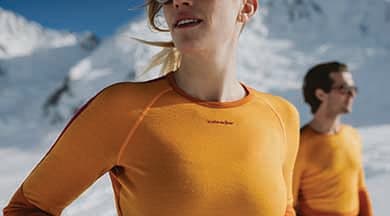icebreaker Guide to Ski Clothing
December 7, 2023 | icebreaker
Whether you’re new to the slopes or a seasoned pro, skiing is a great way to keep active and enjoy winter’s beauty. But to enjoy a day on the powder to the max, you need the right ski clothes to keep you warm, dry and comfortable. In this ultimate guide, we'll cover all the essentials when it comes to men’s and women’s clothing for snow. We’ll also give you a rundown of the layers that make up a perfect ski outfit.
Base layers: Building your foundation
When it comes to ski clothes, it’s all too easy to focus only on those warm outer layers like fleeces, insulated jackets, and ski pants. But a good foundation is just as important.
Think of your base layers (thermal tops, leggings, socks, and other underwear) as the foundation of your ski wardrobe. It’s there to both help you lock in heat and help keep you dry when you’re working up a sweat.
When it comes to the best materials for your base layer and ski socks, there are lots of options. But Merino wool is a particularly good choice as its superior ability to regulate temperature and manage moisture means you stay both warm and dry all day long.
Merino wool ski socks can be a particular game-changer for your feet. Providing cushioning and warmth without any bulkiness, they offer a comfy and dry fit when in your ski boots. They are also naturally antimicrobial, which means they resist odors even after a full day (or several days) of skiing. If you invest in nothing else, a great pair of men’s or women’s ski socks can transform your skiing experience.
Tips for choosing base layers
If you’re on the hunt for new base layers, look for items with a snug fit that hugs your body while still allowing for a full range of motion. Clothing in this layer shouldn't feel constrictive. Rather, you're aiming for a 'second skin'.
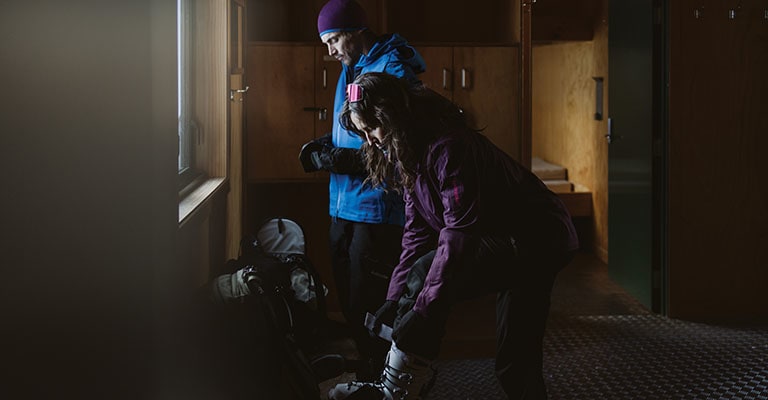
First layers and mid layers: All about insulation
Your first and mid layers are all about locking in the heat. First layers (like short or long-sleeve tees) as well as mid layers (such as light jackets and fleeces) don’t need to be as tight as the base layer. But they should still fit well under your next layers without being too bulky. It's about balance: too tight, and you'll restrict movement and trap moisture. Too loose, and you won't retain enough heat.
When it comes to materials for mid-layers, fleece, especially icebreaker’s Realfleece™, is a classic choice. Merino has an excellent warmth-to-weight ratio, wicks away moisture and dries quickly. For colder conditions, consider a thicker fleece, insulated vest, or insulated jacket. Our MerinoLoft™ technology is low bulk and machine washable.
Importantly, remember that layering is flexible. So take off or add in layers as you need to. For example, on those days when the temperature plummets, you might find that one mid layer isn't enough. It's perfectly fine to wear two mid layers, like a lighter fleece under a heavier one, or a down vest over a fleece jacket. Adjust and tweak based on what makes you feel best.
Outer layer: Protection against the elements
Think of your outer layer as your armor against the elements. Its primary job is to stop snow, rain, and wind from getting in and making you cold. Yet for all the protection it offers, your outer layer still needs to allow sweat and excess heat to escape. For this reason, a good outer layer will be both waterproof and breathable.
When picking outer layers, pay attention to the waterproof rating. A higher number means better protection. Features, like taped or sealed seams and waterproof zippers, add an extra level of defense against moisture. For breathability, look for pit zips or other ventilation systems that allow you to regulate temperature.
Additionally, consider the fit and features of your outer layer. A snow skirt can prevent snow from getting up into your jacket during falls. Adjustable cuffs can help seal out the cold. For pants, reinforced areas can add durability in high-wear zones such as the knees and seat.
Your outerwear should also offer freedom of movement. So look for articulated joints and a cut that offers enough room for your mid-layers without being too bulky.
Accessories: Finishing touches
When it comes to clothes for the snow, don't forget about things like gloves, hats, neck gaiters, and sunglasses. Gloves need to be waterproof, to prevent dampness from any falls. Make sure your hat or beanie covers your ears too, as wind chill can be very uncomfortable.
To finish, wraparound sunglasses are a great idea. Particularly if you’re new to skiing, it’s easy to underestimate how much sunlight the snow reflects.
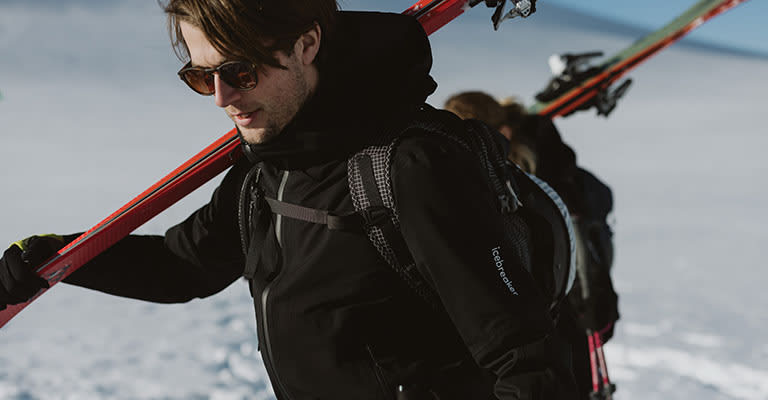
Layering for different weather conditions
Here’s a quick guide to layering depending on the weather. Of course, always adjust your clothing based on your own unique comfort level and the kind of activity you’re doing. For example, if you’re exercising vigorously, you might need fewer layers. Whereas less intense exercise on the slopes might mean you’ll need to add in more.
• Mild weather: A light base layer and a breathable outer shell may be all you need.
• Cold weather: Add a warm mid-layer. Consider Merino wool for extra warmth such as jackets and fleeces using our RealFleece™ or MerinoLoft™ technology.
• Wet weather: Ensure your outer layer has a high waterproof rating to keep you dry.
Caring for your ski clothes
Proper care will extend the life of your ski clothes a long way. So always follow the washing instructions on the label, and consider reapplying a water-repellent coating to your outer layers if and when necessary.
Also, never pack away ski clothing while still damp, as this can lead to mold. And while some ski clothes should never be put in the dryer, many can be. For example, many garments made from Merino will do perfectly fine in the dryer on a low and gentle setting. For more information on how to best care for your merino garments, you can check out the icebreaker care guide.
Get the perfect ski gear
Having the right ski clothing is key if you’re hoping for an enjoyable day on the slopes. That applies just the same for any cold weather activity: quality snow clothes for women and men are a necessity when the temperatures start to fall. From foundation pieces to protective outer shells, each piece plays an important role.
At icebreaker, we’ve got all the base and first layers, mid layers, and outer layer you need for a great day on the powder. Plus, we’ve got a range of hats, neckwear, and other accessories, so you can be sure you’ve got everything you need.
More for you

How to choose socks for skiing | icebreaker
21st February, 2023 | icebreaker
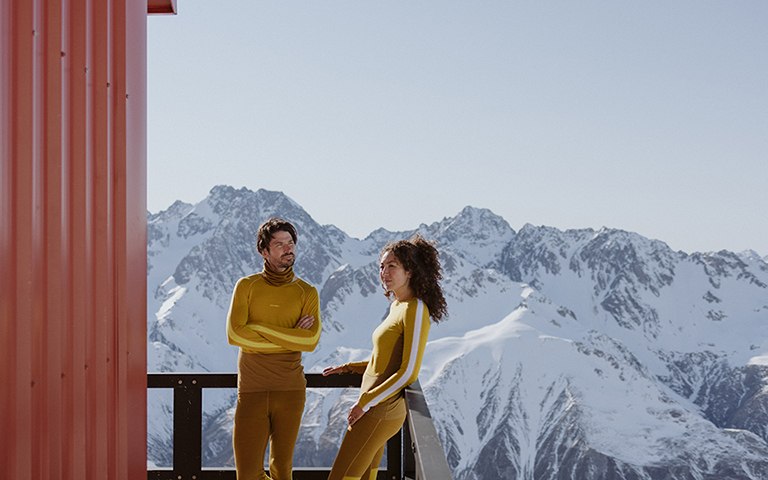
How to use base layers for warmth | icebreaker
15th December, 2022 | icebreaker
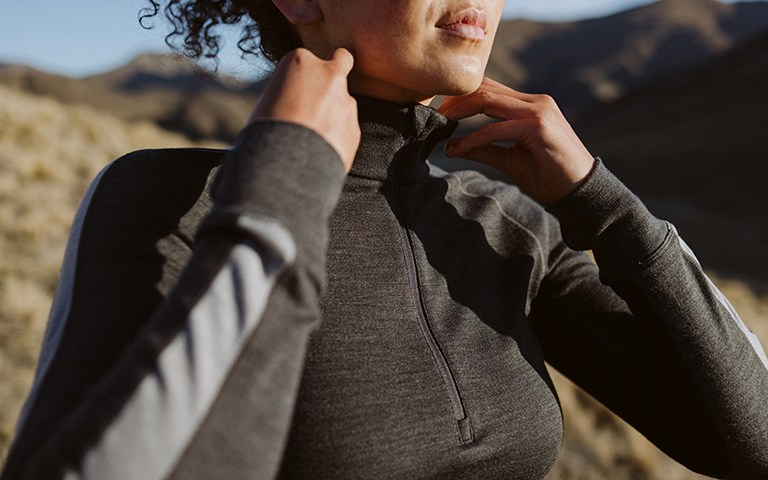
Which fabrics insulate best? | icebreaker
27 October 2022 | icebreaker

